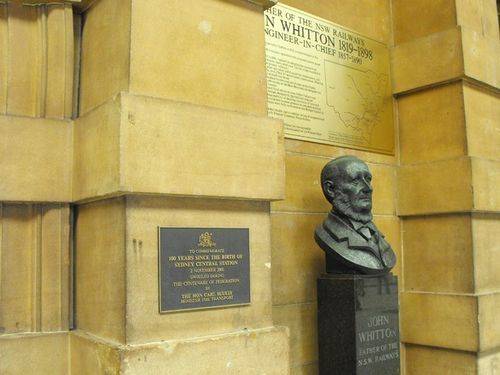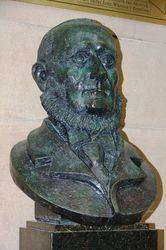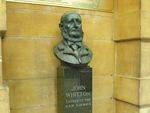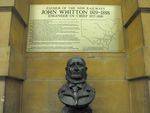
John WhittonPrint Page 
The portrait bust commemorates John Whitton who was appointed Engineer-in-Chief of the New South Wales Railways in 1867, a position he held until his retirement in 1890.
John Whitton (1820 – 1898), was the Engineer-in-Charge for the New South Wales Railways, serving between 1856 and 1899, considered the Father of New South Wales Railways. Under his supervision, it is estimated that 3,494 kilometres of railway around New South Wales and Victoria were completed.
Whitton was responsible for the construction of the Blue Mountains railway line and parts of the Main Western railway line, in particular the Great Zig Zag near Lithgow, and much of the Great Southern Line.
Location
| Address: | Eddy Avenue , Central Station, Haymarket, 2000 |
|---|---|
| State: | NSW |
| Area: | AUS |
| GPS Coordinates: | Lat: -33.882641 Long: 151.206637 Note: GPS Coordinates are approximate. |
Details
| Monument Type: | Sculpture |
|---|---|
| Monument Theme: | People |
| Sub-Theme: | Government - Colonial |
| Approx. Event Start Date: | 1857 |
| Approx. Event End Date: | 1890 |
| Link: | http://adb.anu.edu.au/ |
Dedication
John Whitton
Father of the N. S. W. Railways
Plaque :
Father of the N. S. W. Railways
John Whitton1819 - 1898
Engineer-in-Chief 1857 - 1890
John Whitton, an Englishman who emigrated to Sydney in 1856, is acknowledged as the "Father of New South Wales Railways". His foresight an uncompromising will overcame opponents who proposed narrow gauge horse-drawn train on wooden rails.
Whitton, Engineer-in-Chief from 1857 to 1890, insisted on adopting the standard rail gauge of 4ft 8in (1435 mm) using steam trains on heavy steel rails. This set a high standard of construction which formed the basis of our present railways. When Whitton was fisrt appointed to plan rail routes and to supervise construction, only 37km (23 miles) of track was open to traffic, with 27km (17 miles) under construction. When he retired 33 years later, 3,538km (2,199 miles) of track was in use.
He took rail to the Victorian and Queensland bordes and saw it open up the State`s hinterland. In crossing the extremely difficult terrain of the Blue Mountains he designed two zig-zags and an array of deep cuttings and tunnels. Rail extensions to country centres crossed flood plains on long timber viaducts and spanned main rivers with iron lattice trussed bridges designed by this brilliant engineer.
Whitton had the unenviable task and responsibility of deciding the routes of lines and controlling huge expenditure. He was often subjected to great pressure in turbulent political times, but his honour, integrity and competence were fully confirmed by the Bridges Inquiry of 1884 - 86.
Whitton retired in 1890 and suffered broken health and a constant feeling of unappreciated service until his death in 1898. His grave is in St Thomas` Cemetery, North Sydney.
The State of New South Wales owes much to John Whitton for the successful foundation of the Railways which ensured the progressive development of the Premier State.









